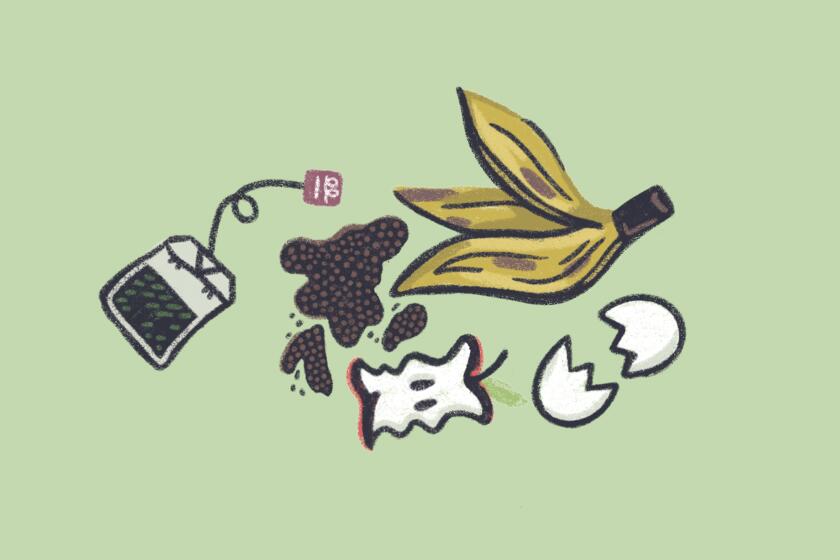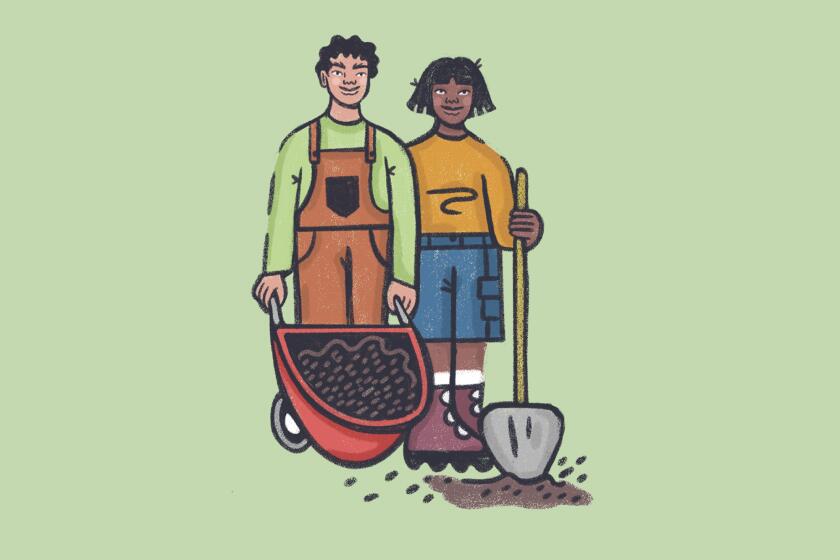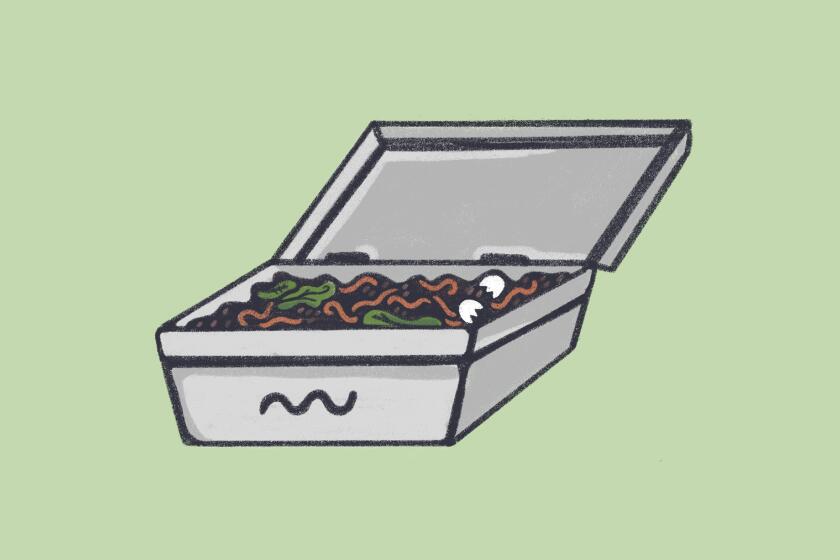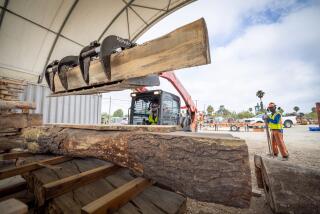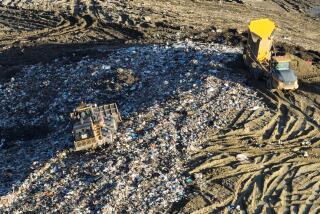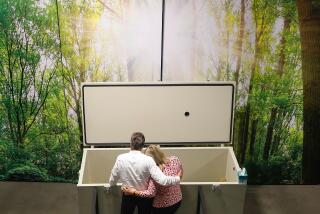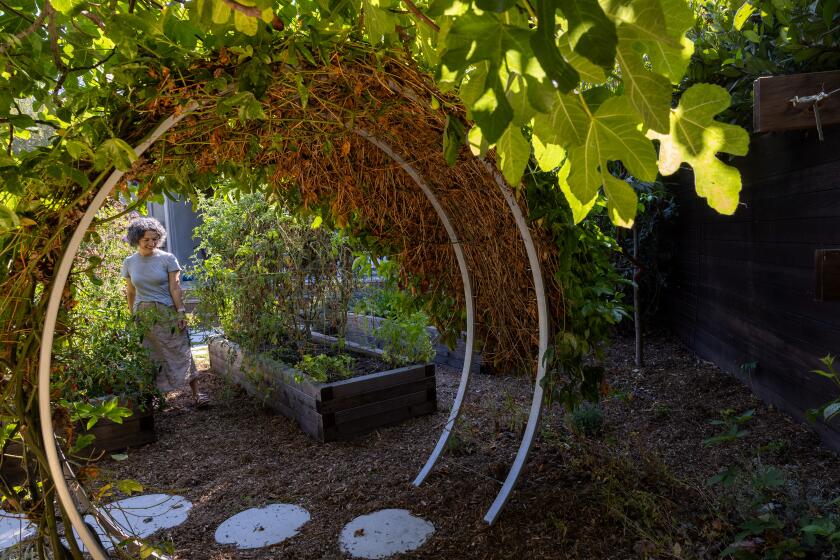Help save the world by composting your kitchen scraps. Here’s how
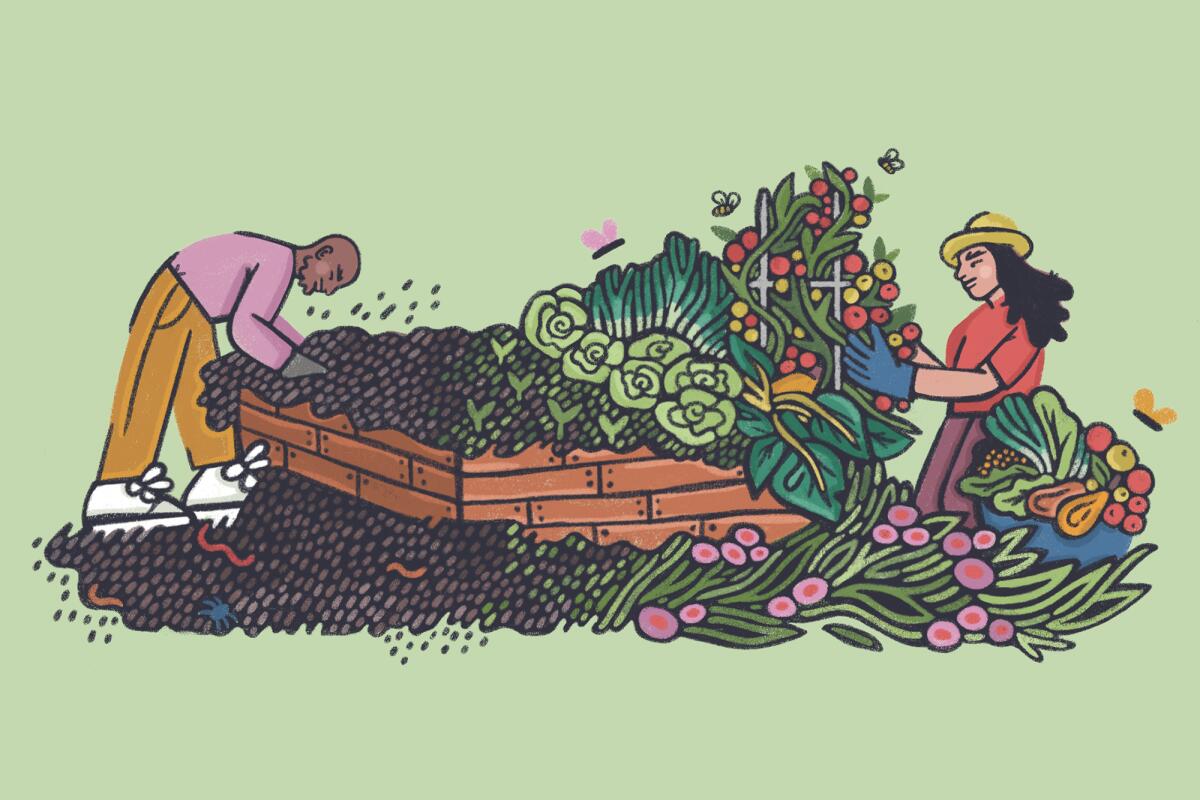
- Share via
The howls on social media have been fierce since the state started mandating that food waste stay out of garbage destined for the landfill. But here’s a confession from a longtime composter: Putting food waste in a separate kitchen receptacle is a no-brainer that actually feels good because it’s such an easy way to improve the world.
See, our landfills are getting full, and organic materials such as kitchen scraps and yard trimmings make up about 50% of the state’s landfill “trash,” according to CalRecycle, creating enough global-warming methane gas to make landfills California’s third largest methane source.
All those organic materials creating problems in our landfills are actually a misunderstood asset that can easily be converted to compost — the miracle soil amendment that rebuilds our depleted soils while nourishing our plants. All we have to do is scrape our plates into a compost bucket instead of the trash bin.
“Nearly 40% to 50% of the trash we collect curbside is compostable,” said Michael Martinez, founder of L.A. Compost. “We need to stop seeing food ‘waste’ as trash and redefine our vocabulary to see it as a resource, something that needs to be transformed and reinvested back into the soil.”
A new law requires Californians to recycle food scraps and leftovers. What is composting? What can you — and can’t you — compost? We’re here to help.
That’s the goal behind the part of Senate Bill 1383 that went into effect Jan. 1, mandating that local jurisdictions create a way for households to separate food and yard waste from landfill garbage and use it instead to create compost, mulch or biofuels. The state left implementation of the law to California’s 400-plus local governments, and each jurisdiction is coming up with its own rules about how to manage food waste (about a quarter already have programs in place, according to CalRecycle spokesperson Maria West).
The goal is to divert 75% of organic waste disposal from landfills by 2025 — an ambitious task considering that some jurisdictions like Long Beach and the city of Los Angeles are still trying to get their programs up and running. (L.A. Sanitation staff will be presenting their implementation plan to the City Council on Feb. 3, according to spokesperson Heather Johnson.)
So here’s a proposal: Separating our food waste is a win-win for anyone who likes to breathe and eat food, so even if your jurisdiction is still designing its program, why not start practicing now by becoming a composter?
If you have a yard, you can easily start a compost pile. Send items you don’t want to include, like bones or moldy cheese, to professional waste treaters and use the rest of your household food waste to create excellent and free soil amendments for your garden. No yard? No problem! Consider a small-space option like bokashi or worm composting (see sidebar) or connect with a co-op that will do it for you.
Get composting
What you need
1. Closable containers are critical for separating your food waste. There are myriad compost pails available for $25 to $50 — many handsome enough to sit on your kitchen counter. It should have a tight-fitting lid to stop odors and deter pests and be big enough to hold a few days’ worth of scraps. (Most jurisdictions are now offering free or low-cost bins.)
2. Garden forks are a must for turning compost piles, a vital step to keeping the ingredients aerated and pests at bay. (A shovel will work in a pinch.)
3. High-nitrogen “green” materials help kick-start a compost pile’s decomposition. Soil scientist and L.A. Compost advisor Lynn Fang recommends having a good supply of these materials on hand to help the microbes do their work in breaking down the materials. These include grass clippings (well mixed with other materials so they don’t compact), coffee grounds, brewery waste (the leftover grains from making beer) and aged manure (left out in the sun at least three weeks) from cows, horses and chickens not treated with steroids, antibiotics or other chemicals.
4. Wood chips from untreated wood are useful carbon or “brown” ingredients, good for absorbing odors, keeping the pile aerated and covering newly added food waste, said Fang. You can request free loads of wood chips from local tree trimmers or sign up for a free delivery on chipdrop.com. (Note: One delivery can include up to 20 yards of wood chips, an amount that can easily cover a driveway, so talk to neighbors and friends about sharing. The site also has a way for you to network with others who either want chips or have some to share.) Fang said L.A. Sanitation or other cities have free mulch pickup sites if you want a smaller quantity of chips. Other “brown” options include shredded cardboard, dried leaves, straw or hay, all of which should be well mixed with other items so they don’t compact and impede air flow.
5. Space — preferably in a shady area — to set up a compost bin, tumbler or pile.
In the helpful-but-not-absolutely-necessary category is a compost thermometer to keep track of your compost’s internal temperature (which is a must if you’re trying your hand at hot composting).
Creating a compost pile
Compost requires four main ingredients: water, oxygen, nitrogen — from “green” items such as fruit and vegetable trimmings, grass clippings, tea leaves and egg shells — and carbon — from “brown” items such as dead leaves, shredded newspaper and sawdust (from untreated wood). A compost pile should be damp, like a squeezed-out sponge, but not dripping, and the more often you turn it and give it oxygen, the faster the microbes can break the materials down to an earthy-smelling, chocolate-brown amendment for your soil. You don’t have to turn it at all, but it will take much longer for all the materials to break down.
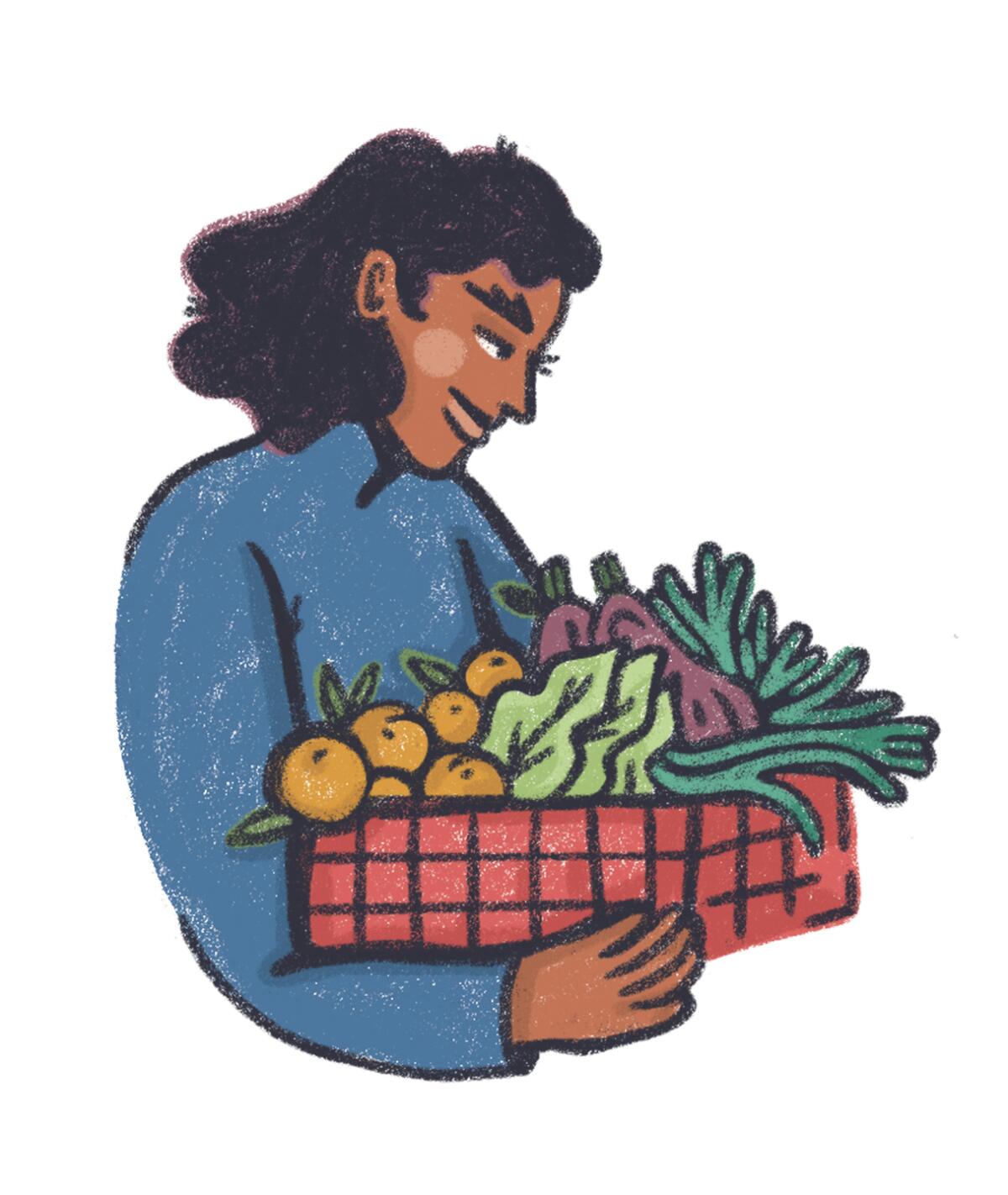
The instructions here are for casual composters, who won’t be using meat, dairy or cooked foods. Those items can be composted in hot piles, says Fang, but those require more effort and diligence.
Guides abound online, such as these from L.A. Compost or master gardener Yvonne Savio’s website, GardeninginLA. Here are Fang’s recommendations for starting a basic compost pile by layering in multiple ingredients:
1. Start with a 3- to 6-inch layer of untreated wood chips or small broken branches at the bottom of a bin or just on the ground. This will help absorb odors and provide air circulation.
2. Add a 3-inch layer of green or nitrogen items, such as vegetable trimmings and eggshells.
3. Add a 1-inch layer of a high-nitrogen activator such as manure, brew waste or coffee grounds. If you use grass clippings, make sure to mix them in with other items so they don’t compact.
4. Add a 3-inch layer of brown or carbon ingredients, such as wood chips, shredded newspaper or cardboard, straw or hay, pine needles or dry leaves (well mixed with other ingredients so they don’t mat).
5. Water those layers well so the pile is thoroughly wet, and if you have enough ingredients, repeat the same layering process, watering again to ensure all the ingredients get wet.
6. Turn the pile monthly by forking ingredients from the bottom of the pile to the top. When you add food scraps, cover them with wood chips or some other brown material to absorb odors and deter pests, but try to keep an even balance of greens and browns and make sure the pile stays moist. If the pile gets too dry, decomposition slows and it’s more likely to attract ants and other pests. Add more greens and water, and turn. If the pile starts smelling or gets too wet, add more brown carbon material and mix it well.
7. Once you fill a bin, let it “cook” for a few months (turning it monthly will speed the process) and start a second bin or pile nearby so you always have a place to add your food waste.
Using compost
If you turn it monthly, compost can be ready in three to six months. Finished compost has a pleasant earthy smell and a dark brown color like coffee grounds. You shouldn’t be able to recognize the ingredients, but if you find big chunks, just put them in the new pile to further break down.
Use your compost as a soil amendment, mixing it into your garden beds or containers. Or spread it a few inches thick under plants as a kind of fertilizing mulch that will feed their roots as it breaks down while cooling and enriching the soil. L.A. Compost suggests a ½-inch side dressing of compost for heavy-feeding vegetables like tomatoes. Even lawns can benefit from a thin (½ inch) layer of compost raked over the top.
Compost also can be added to water (L.A. Compost recommends about 2 to 4 cups of loose compost to 5 gallons of water) and left to “brew” for 24 to 48 hours. The resulting “tea” can be used to fertilize plants as they’re being watered. It also can be used a foliar spray to feed plants through their leaves.
More to Read
Sign up for The Wild
We’ll help you find the best places to hike, bike and run, as well as the perfect silent spots for meditation and yoga.
You may occasionally receive promotional content from the Los Angeles Times.

